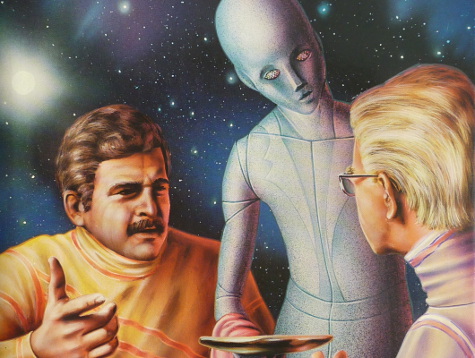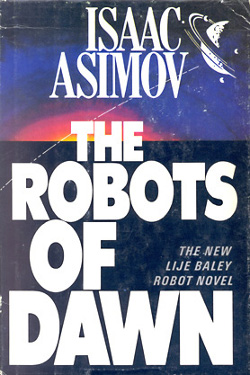
For Isaac Asimov’s detective, Elijah Baley, it’s been two long years since he’s set forth on an interstellar adventure, and though he once shuddered at the thought of hyperspace travel, he’s now itching to once again do some planet hopping.
However, for Asimov enthusiasts, the wait was a great deal more labored. There is a span of twenty-six years between The Naked Sun (1957) and The Robots of Dawn (1983), the next full-length sci-fi/mystery whodunit featuring Baley and his robot partner Daneel Olivaw. Patient fans’ appetites were whetted with a Baley and Daneel short story that appeared in a 1972 issue of Analog Science Fiction and Fact called, “Mirror Image.” Asimov said the general reaction was, “Thanks, but we wanted another novel.” Let’s take a look and see if it was worth nearly three decades of yearning.
Baley has been promoted to a higher C-7 rating that allows him to go outside the concealed city and is attempting to begin again, so to speak, with a select group of agoraphobic humans—experiencing air, dirt, and other dizzying aspects of nature that in this future Earth is mostly patrolled by robots. His nineteen-year-old son, Bentley, is on this particular exploit and is also planning to go into space. Baley’s wife, Jessie, who played an important role in the first novel, is only mentioned in passing—she is much more comfortable staying within the hive. As Baley returns after one such jaunt outside, he reflects on the caves of steel:
Baley felt his breath drawn in tremulously and he gladdened in the realization that he was home and safe with the known and knowable.
That was what always happened. Again he had accepted the City as the womb and moved back into it with glad relief. He knew that such a womb was something from which humanity must emerge and be born.
 Baley is now a bona fide hero after a hyperwave dramatization (kind of like a movie of the week streamed universe wide) recounted, with great embellishment, the events of his last murder case on the planet Solaria. And, while cracking that case raised respect for Earthling’s in the eyes of the other planets and gained him an upgrade in professional ranking, it also netted the ire of his superiors by unveiling the ineptness of his own government. So, when Baley’s friend—the 165-year-old Dr. Han Fastolfe—requests assistance on Aurora, the largest of all Spacer worlds, Baley goes knowing that if he fails, his bosses will be in a good position to place the blame squarely on him.
Baley is now a bona fide hero after a hyperwave dramatization (kind of like a movie of the week streamed universe wide) recounted, with great embellishment, the events of his last murder case on the planet Solaria. And, while cracking that case raised respect for Earthling’s in the eyes of the other planets and gained him an upgrade in professional ranking, it also netted the ire of his superiors by unveiling the ineptness of his own government. So, when Baley’s friend—the 165-year-old Dr. Han Fastolfe—requests assistance on Aurora, the largest of all Spacer worlds, Baley goes knowing that if he fails, his bosses will be in a good position to place the blame squarely on him.
Teaming once again with Daneel, a robot that is nearly indistinguishable from a human, they begin investigating the roboticide (term coined by Baley and Daneel on the journey to Aurora) of Jander Panell, the second humaniform ever designed. Jander’s mind was destroyed in what Aurorans call a “mental freeze-out.”
Like the murder case of The Naked Sun, there is only one logical explanation, and, in this outing, that explanation is Fastolfe committed the crime because he alone—as the leading theoretical scientist—has the knowledge to “murder” Jander. Fastolfe maintains that “a spontaneous event in the positronic brain paths” caused the freeze-out, then just as quickly admits it’s highly unlikely.
As Baley prods and pokes for information, it’s apparent that not everyone is an admirer of the celebrity investigator. Fearing his life is in danger, he’s surrounded by a large contingent of robots for his safety. And yet, despite all their efforts, it’s somehow missed that an airlift he’s riding in has been sabotaged:
The airfoil came down with a bump and a short, harsh, scraping noise.
The doors flew open, one on either side, and then closed with a soft, sighing noise. At once, the robots were gone. Having come to their decision, there was no hesitation and they moved with a speed that human beings could not duplicate.
Asimov’s 1983 tech includes an “Astrosimulator” that creates the sensation of being in space, a “Spicer” that delivers a dozen different seasonings at the flip of a wrist, and the “Personal,” which is a Trek-like holodeck bathroom, where Baley’s senses are enlivened when washing his hands under a replicated image of a running waterfall, complete with soap. Nothing earth shattering, though the “Astrosimulator” is very much with us in the form of virtual reality goggles, and I, for one, am still longing for the holodeck.
In the hyperwave dramatization, it’s implied that Baley had an affair of sorts with Gladia Delmarre, the widow of the murder victim in Sun. She conveniently returns, having relocated to Aurora, and, you guessed it, is involved with the erased robot…Asimov is anything but subtle.
More surprising is the improvement in Asimov’s handling of female characters—feminism happened and Asimov must have been paying attention because, compared with the last adventure, the Gladia of Robots is more three-dimensional, operating on an intellectual level with Baley and carrying the secret of a relationship with the “murdered” Jander. Despite the advancement, the female voices, even if technically interesting, continue to have a tendency to be clumsy—like Gladia’s dialogue struggling through some inelegantly wrought emoting and embarrassingly touching on orgasms and masturbation.
All that aside, when Asimov switches back to the future of mankind, expressing the need to vacate this planet and move out among the stars (as esteemed scientist Stephen Hawking has recently stated), it’s essential reading. Almost like Humanity 101.
In The Robots of Dawn, Asimov begins connecting his universe by mentioning Dr. Susan Calvin, a heroine of his classic I, Robot (1950) collection. This technique would be further utilized in the fourth novel, Robots and Empire, where he began connecting his Robot books to his equally acclaimed Foundation series, and Daneel goes on to become the focal point, where it’s gradually revealed he’s guiding humankind toward idealized goals.
Fans of the first two novels and the short story “Mirror Image” will be much rewarded by The Robots of Dawn’s more mature setting, though I wouldn’t necessarily recommend the uninitiated dive-in here. The Baley/Daneel relationship—the heart of this series—is best viewed from the beginning with The Caves of Steel (1954), when these two opposites meet, not knowing that their partnership would change the future.
To learn more or order a copy, visit:
opens in a new window![]() opens in a new window
opens in a new window![]() opens in a new window
opens in a new window![]() opens in a new window
opens in a new window![]()
David Cranmer aka Edward A. Grainger is the publisher and editor of BEAT to a PULP books and author of The Drifter Detective #7: Torn and Frayed. He lives in New York with his wife and daughter.

David, I have been planning to read I, ROBOT after watching the eponymous movie inspired by Asimov’s collection. I am guessing THE ROBOTS OF DAWN has nothing to do with the I, ROBOT sf stories. THE NAKED SUN is another book I have been meaning to read for a long time.
There’s like 30+ short stories and 5 novels, Prashant. Written by Asimov featuring positronic robots and sometimes that’s simply the connection. The Robots of Dawn is part of that series.
I read these but it has been a long time now. Good to get a flashback to the past.
Glad to shine a light, cgramlic!
“As Wembley and the country falls silent, I will think of that and her 70 years of impeccable duty.”